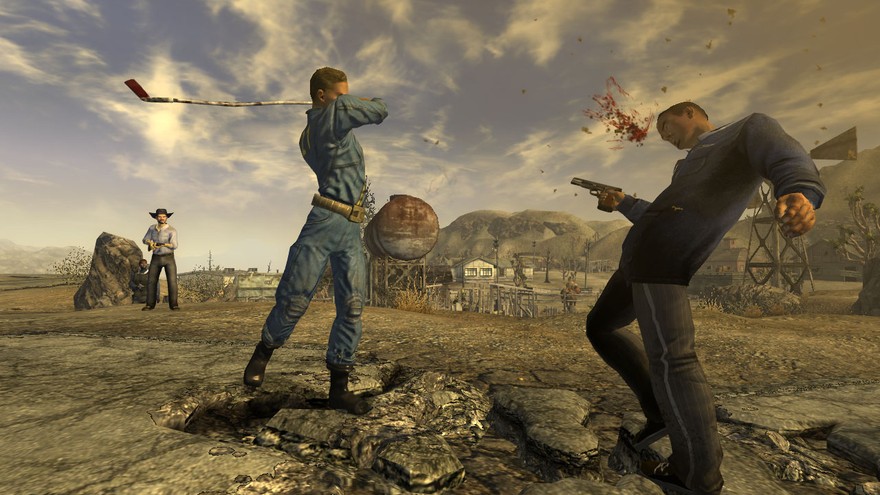“Vegas was always one of a kind. What you see down on the Strip is just a fraction of the city’s former glory, and yet . . . more than an echo. I preserved its spirit.”
-Robert Edwin House, President, CEO, sole proprietor of the New Vegas Strip
The Fallout series has always walked a thin line between parody and homage with its good ol’ boy ‘50s aesthetic. The massive disparity between the cheery “golly gee” iconography and the detritus of the post-nuclear wasteland has become the signature dark humor for which the series is known. Developed by Bethesda in-house, Fallout 3 arguably has the most heart: the story revolves around the relationship between the player and Liam Neeson, who also happens to play the protagonist’s father. But emotional sincerity has never been the series’ trade; the followup New Vegas, developed by RPG journeymen Obsidian, was a return to form.
Fallout: New Vegas is all tribute. The game’s few cutscenes are largely rendered in smoky documentary format, narrated in fuzzy voiceovers. The New Vegas strip is enthralled to its past, the product of Mr. House, a madman in a casket who was so in love with the idea of the old Vegas that he rebuilt it from apocalyptic ruins. Caesar forms a post-apocalyptic legion modeled after the Roman Empire; the New California Republic tries to establish order in the wasteland, flying a two-headed bear on their flag. Compared to the aphoristic martyr narrative of Fallout 3, New Vegas would almost qualify as heady political drama—if, that is, it didn’t keep Vegas itself front and center.
The world outside the New Vegas strip has splintered into barbarism, tribal warfare, squabbling politicos scrapping for basic needs, while Mr. House and his kin cling doggedly to a decidedly American dream in their constellation of heavily-guarded casinos. “We do what we want here, because we can,” is the reigning notion within the well-manicured walls, where the privileged denizens can play at slots and blackjack without a thought to the world outside.
The layers of irony are thick enough here that it’s important to lay each one out in turn. Consider, then:
- The New Vegas Strip is Mr. House’s dreamy utopian parody of Vegas.
- On top of that, the city of Las Vegas in real life is already a decaying parody of human culture and achievement. Behold the shitty sphinx, the gleaming rows of casinos. Did the “former glory” of which Mr. House speaks ever actually exist?
- The entirety of Fallout: New Vegas is a parody of/homage to “American-ness” in its emphasis on survivalism and brutal capitalism. Even after the end of the world, Mr. House is the grinning CEO making bank off of lone-ranger types who just want to escape the heat.
Fallout: New Vegas is a parody of/homage to “American-ness” in its emphasis on survivalism and brutal capitalism. Even after the end of the world, Mr. House is the grinning CEO making bank off of lone-ranger types who just want to escape the heat.

Thus we have a parody of a parody, presented within a parody. To visit the city of Las Vegas is to “get away” from real life to a synthetic oasis: we leave real life behind to play slots and party hard in Las Vegas. In playing Fallout: New Vegas, we become the escapists. It’s painfully self-aware, ghoulishly dark, and quintessentially Fallout, which is to say, it’s also quintessentially human. And to be human in Fallout is to be beautifully, irredeemably broken.
“So much modern art is the sound of things going out of control, of a medium pushing to its limits and breaking apart,” Brian Eno wrote in A Year With Swollen Appendices. “The excitement of grainy film, of bleached-out black and white, is the excitement of witnessing events too momentous for the medium assigned to record them.”
The world of Fallout is a world off the rails, without safety nets. America penetrated the Mojave Desert with water pipelines and gas mains to build Las Vegas, a monument to unbridled fun, a place where “what happens in Vegas stays in Vegas.” Fallout: New Vegas shows us the frontier repatriated to its former wilderness, the once-tamed wasteland now untamed. Mr. House’s New Vegas is humanity’s first attempt in Fallout to recapture the glitz and excess of its former glory. The draw of every Fallout game is ruin and devastation: we are less in love with the location or even the utopic vision than we are in love with how broken it is, how obviously it does not work. Brokenness signifies realness: in an age of polish and sheen, we are starved for the real thing.
Isn’t the fixation on dystopian and apocalyptic narratives—the works of Robert Kirkman and Cormac McCarthy and countless others—just a reflection on our desire to go back to “the way things were”? A century ago, the American consciousness was shadowed with a sense of the wildness of life, of the desolation of nature: a bout of bad luck or hard winter might kill your entire family. There was purity in the severity of survival.
Fallout: New Vegas is a kind of wish fulfillment for the old ways. It’s a return to form. It’s a vision of American society, diminished and remade, transliterated to virtual space. Vintage-era swing-tunes are transmitted via AM radio and broadcast through the crackling speakers of the Courier’s Pip-Boy, somewhat changed, yet still conveying the spirit of optimism of the era in which they were first sung. While Mr. House is building his vision of the past, Fallout: New Vegas is also striving to build its own vision of the past, in the future.
Before you enter the vault, be sure to back our Kickstarter to help relaunch our print magazine!
